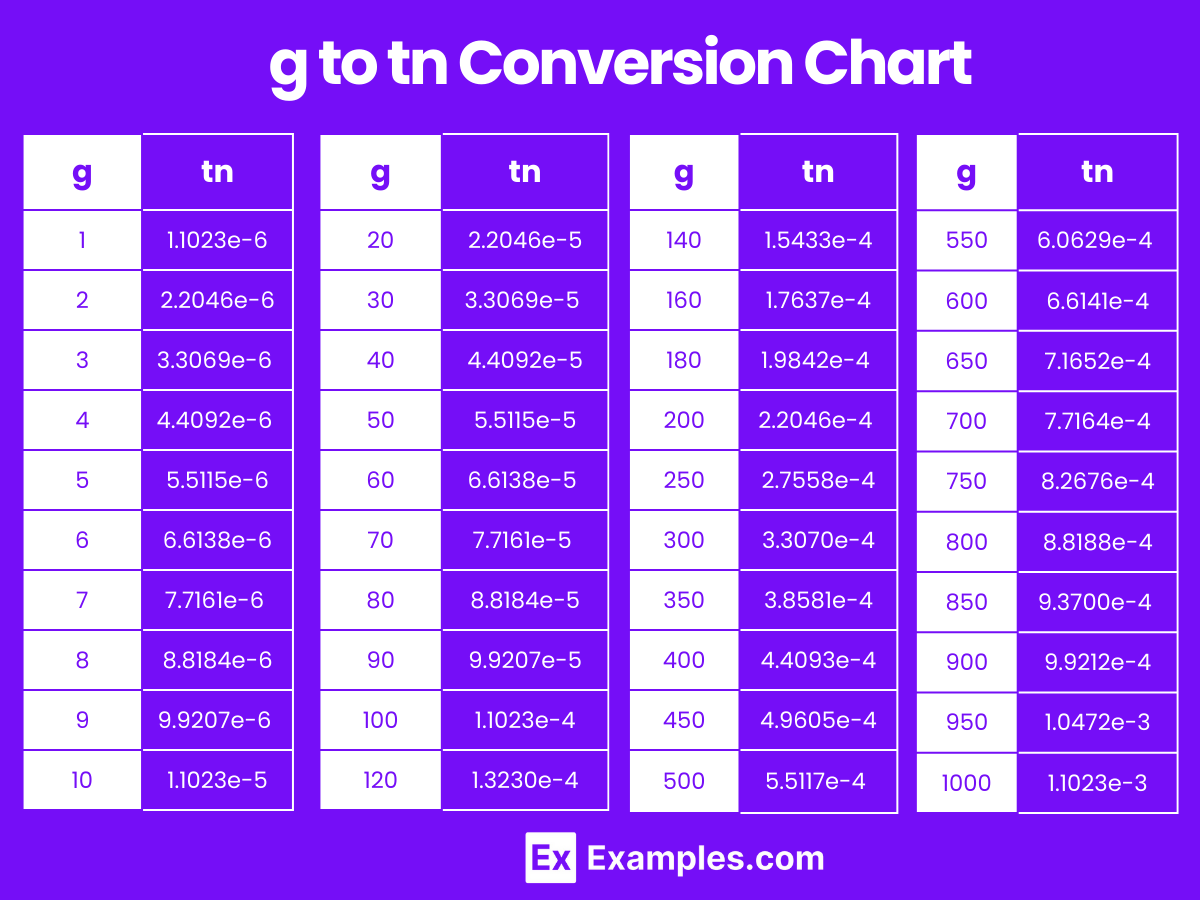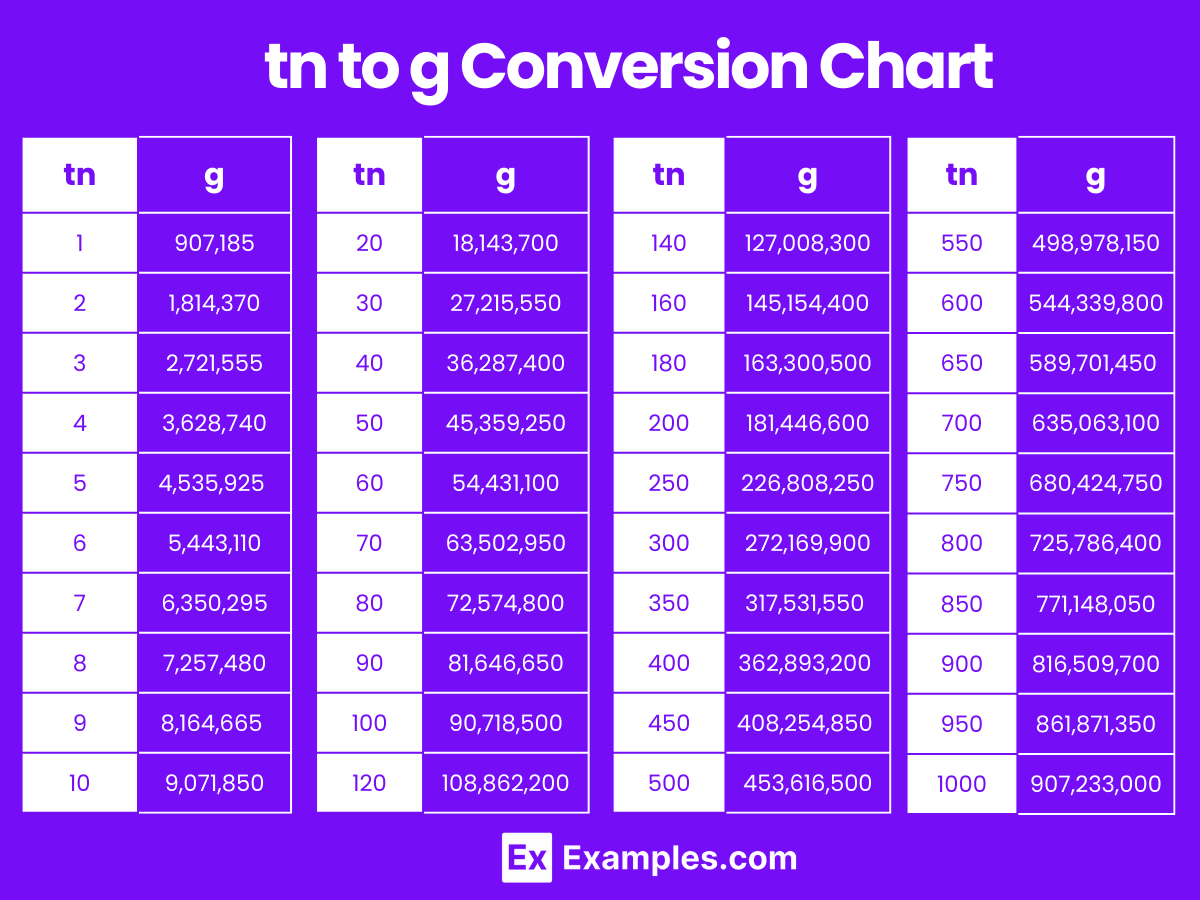Effortlessly convert between grams to US tons and vice versa using Examples.com. Enter your measurements for quick conversion results.
Gram to USTon
Formula: Mass in USTon (tn) = Mass in Gram (g) × 1.102×10-6
| Gram | USTon |
|---|---|
| 1 | 0.00000110231 |
USTon to Gram
Formula: Mass in Gram (g) = Mass in USTon (tn) × 907185
| USTon | Gram |
|---|---|
| 1 | 907185 |
Mass Converters to Gram (g)
| Tonne to Gram | Kilogram to Gram | Milligram to Gram |
| Microgram to Gram | Imperial ton to Gram | US ton to Gram |
| Stone to Gram | Pound to Gram | Ounce to Gram |
Mass Converters to US ton (tn)
| Tonne to US ton | Kilogram to US ton | Gram to US ton |
| Milligram to US ton | Microgram to US ton | Imperial ton to US ton |
| Stone to US ton | Pound to US ton | Ounce to US ton |
Conversion Factors:
- Grams to US Tons: 1 gram = 0.0000011023 US tons
- US Tons to Grams: 1 US ton = 907,185 grams
How to Convert Grams to US Tons:
To convert grams to US tons, multiply the number of grams by 0.0000011023.
US Tons=Grams×0.0000011023
Example: Convert 2,000,000 grams to US tons.
US Tons=2,000,000×0.0000011023=2.2046 tons
How to Convert US Tons to Grams:
To convert US tons to grams, multiply the number of US tons by 907,185.
Grams=US Tons×907,185
Example: Convert 3 US tons to grams.
Grams=3×907,185=2,721,555 grams
Grams to US Tons Conversion Table
| Grams (g) | US Tons (tn) |
|---|---|
| 1 g | 1.1023e-6 tn |
| 2 g | 2.2046e-6 tn |
| 3 g | 3.3069e-6 tn |
| 4 g | 4.4092e-6 tn |
| 5 g | 5.5115e-6 tn |
| 6 g | 6.6138e-6 tn |
| 7 g | 7.7161e-6 tn |
| 8 g | 8.8184e-6 tn |
| 9 g | 9.9207e-6 tn |
| 10 g | 1.1023e-5 tn |
| 20 g | 2.2046e-5 tn |
| 30 g | 3.3069e-5 tn |
| 40 g | 4.4092e-5 tn |
| 50 g | 5.5115e-5 tn |
| 60 g | 6.6138e-5 tn |
| 70 g | 7.7161e-5 tn |
| 80 g | 8.8184e-5 tn |
| 90 g | 9.9207e-5 tn |
| 100 g | 1.1023e-4 tn |
g to tn Conversion Chart

US Tons to Grams Conversion Table
| US Tons (ton) | Grams (g) |
|---|---|
| 1 tn | 907,185 g |
| 2 tn | 1,814,370 g |
| 3 tn | 2,721,555 g |
| 4 tn | 3,628,740 g |
| 5 tn | 4,535,925 g |
| 6 tn | 5,443,110 g |
| 7 tn | 6,350,295 g |
| 8 tn | 7,257,480 g |
| 9 tn | 8,164,665 g |
| 10 tn | 9,071,850 g |
| 20 tn | 18,143,700 g |
| 30 tn | 27,215,550 g |
| 40 tn | 36,287,400 g |
| 50 tn | 45,359,250 g |
| 60 tn | 54,431,100 g |
| 70 tn | 63,502,950 g |
| 80 tn | 72,574,800 g |
| 90 tn | 81,646,650 g |
| 100 tn | 90,718,500 g |
tn to g Conversion Chart

Differences Between Grams to US Tons
| Aspect | Grams (g) | US Tons (tn) |
|---|---|---|
| Definition | A gram is a unit of mass in the metric system. | A US ton is a unit of mass in the US customary system, also known as a short tn. |
| Symbol | g | tn |
| Conversion Factor | 1 gram = 0.0000011023 US tons | 1 US ton = 907,185 grams |
| Usage | Commonly used for measuring smaller quantities of mass. | Used for measuring large quantities of mass. |
| Typical Context | Used in everyday contexts like cooking and small-scale measurements. | Used in industrial, shipping, and heavy-duty contexts. |
| Measurement Precision | Suitable for precise measurements in small-scale contexts. | Suitable for measuring large, bulk quantities. |
| Scale | Smaller scale unit compared to US tons. | Larger scale unit compared to grams. |
| Practical Example | 500 grams of flour for baking. | 20 US tons of construction materials. |
| Applications | Widely used in science, medicine, and daily life. | Commonly used in industries like shipping, construction, and heavy manufacturing. |
| Common Equipment | Measured with kitchen scales, digital balances. | Measured with industrial scales, weighbridges. |
| Historical Origin | Part of the metric system, established in France during the 1790s. | Part of the US customary system, derived from British units used during the colonial period. |
| International Use | Universally recognized and used globally. | Primarily used in the United States and a few other countries. |
1. Solved Examples on Converting Grams to US Tons
Example 1:
Problem: Convert 5,000,000 grams to US tons.
US Tons=Grams×0.0000011023
Solution: US Tons=5,000,000×0.0000011023=5.5115 tons
Example 2:
Problem: Convert 750,000 grams to US tons.
Solution: US Tons=750,000×0.0000011023=0.8267 tons
Example 3:
Problem: Convert 1,200,000 grams to US tons.
Solution: US Tons=1,200,000×0.0000011023=1.3228 tons
Example 4:
Problem: Convert 3,500 grams to US tons.
Solution: US Tons=3,500×0.0000011023=0.0039 tons
Example 5:
Problem: Convert 10,000 grams to US tons.
Solution: US Tons=10,000×0.0000011023=0.0110 tons
2. Solved Examples on Converting US Tons to Grams
Example 1:
Problem: Convert 3 US tons to grams.
Solution: Grams=US Tons×907,185
Grams=3×907,185=2,721,555 g
Example 2:
Problem: Convert 0.5 US tons to grams.
Solution: Grams=0.5×907,185=453,592.5 g
Example 3:
Problem: Convert 10 US tons to grams.
Solution: Grams=10×907,185=9,071,850 g
Example 4:
Problem: Convert 1.25 US tons to grams.
Solution: Grams=1.25×907,185=1,133,981.25 g
Example 5:
Problem: Convert 7.75 US tons to grams.
Solution: Grams=7.75×907,185=7,034,183.75 g
What are some practical uses of converting grams to US tons?
Practical uses include calculating the weight of large shipments, industrial raw materials, and comparing the mass of heavy equipment.
Are there any tools available to convert grams to US tons?
Yes, you can use online conversion calculators, mobile apps, or scientific calculators to easily convert grams to US tons.
Why is it important to convert grams to US tons?
Converting grams to US tons is essential for understanding and comparing large quantities in contexts such as shipping, construction, and industrial applications.
Can gram to US ton conversions be used in scientific research?
Yes, particularly in fields such as environmental science, geology, and physics where large masses are measured and compared.
What are some common errors to avoid when converting grams to US tons?
Common errors include incorrect use of the conversion factor, misplacement of decimal points, and rounding errors. Always double-check your calculations.
How can converting grams to US tons improve efficiency in manufacturing?
It allows for better planning and resource management by providing accurate measurements of raw materials, reducing waste, and ensuring that production processes are optimized for large-scale outputs.

